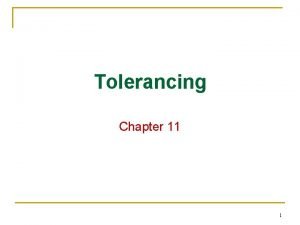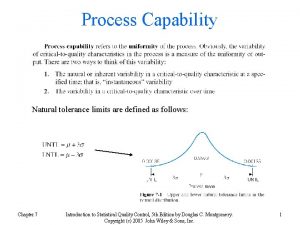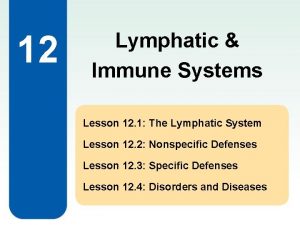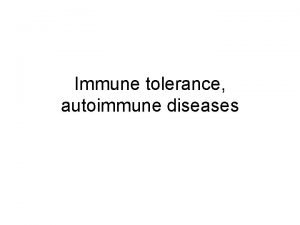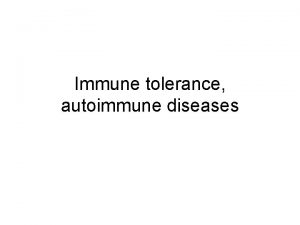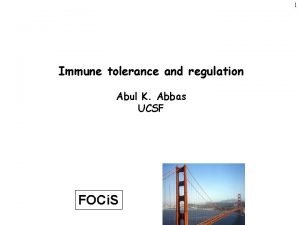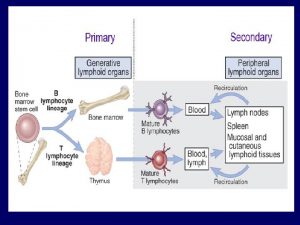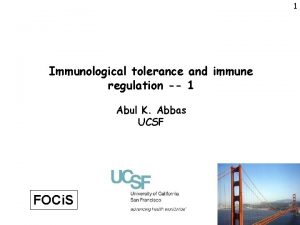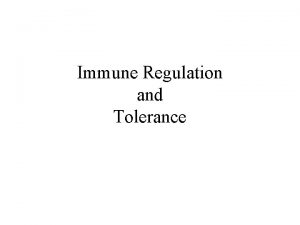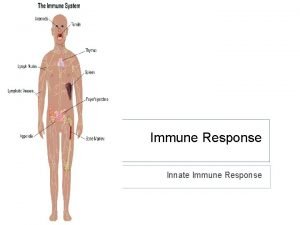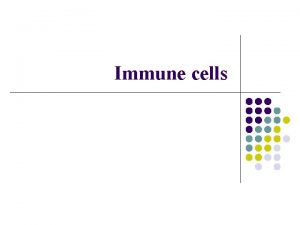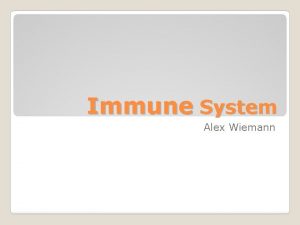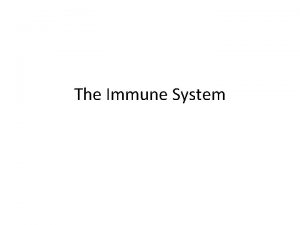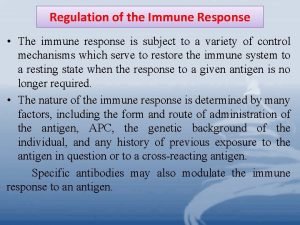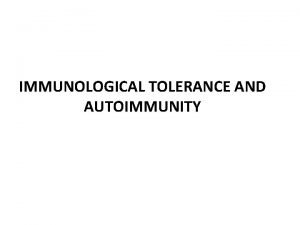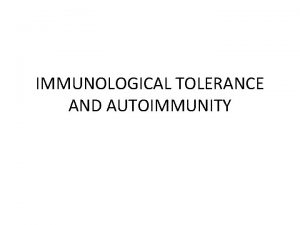Tolerance and Immune Regulation Control of the Immune






















- Slides: 22

Tolerance and Immune Regulation

Control of the Immune Response (Immunomodulation) • Specificity • Self - recognized but not responded to • Nonself - discerned as foreign » Pathogenicity: recognize intracellular/extracellular organisms • Intensity • Sufficient for protection against invading organisms • Prompt down regulation to minimize deleterious effects • Duration • Long enough to generate protection • Generates appropriate intensity for protection • Sufficient to protect host, but does not persist after challenge resolved • Memory retained for future assaults

Mechanisms of Immune Regulation • • Isolation of self antigens (privileged sites) Deletion of self-reactive clones Active immunoregulation to prevent sensitization Down regulation of mature self-reactive clones

Immunological Tolerance General Considerations • Definition • State of unresponsiveness to a particular antigenic epitope while the remaining immune response remains intact. • Only antigen receptor-bearing cells (i. e. lymphocytes) can be tolerized • Types • Central: occurs during lymphocyte development • Peripheral: induced in mature cells • Consequences • • • Apoptosis: clone is deleted (programmed cell death) Anergy: clone is inactivated (but not deleted) (Clonal Ignorance)

Immunological Tolerance Central vs. Peripheral Mechanisms Self reactive clones arise during process of generating B and T receptor diversity. • Central: Negative selection. Ensures that B and T cells that emerge into peripheral tissue react only with foreign antigens. • Peripheral: Other mechanisms must be available for maintaining self tolerance once cells enter B and T cell compartments.

Immunological Tolerance Immature T and B Lymphocytes • Major mechanisms is central tolerance (apoptosis) of self reactive clones. • T Lymphocytes – Negative selection in thymus • B Lymphocytes – Negative selection in bone marrow

Induction of Tolerance Mature T and B Lymphocytes • • Anergy Receptor Editing Deletion Clonal Ignorance

Induction of Tolerance Mature T and B Lymphocytes • Anergy – Functional inactivation of a cell, resulting in nonresponsiveness upon contact with self antigen. • Receptor Editing • Deletion • Clonal Ignorance

Inhibition of Lymphocyte Activation • T cells – Inhibit costimulatory molecules (eg. CD 80, 86) – Anergizes CD 4+ T cells • No more IL-2 • Unresponsive to subsequent antigen challenge – Anergy is a major mechanism of peripheral tolerance

Induction of Tolerance Mature T and B Lymphocytes • Anergy • Receptor Editing – Process where a rearranged immunoglobulin H or L chain gene undergoes secondary rearrangement (under control or RAG-1/RAG-2). Leads to a BCR or TCR with new specificity. • Deletion • Clonal Ignorance

Induction of Tolerance Mature T and B Lymphocytes • Anergy • Receptor Editing • Deletion – Autoreactive T or B cells are eliminated from the repertoire of reactive population. Can occur with cells that bind with extremely high affinity. • Clonal Ignorance

Induction of Tolerance Mature T and B Lymphocytes • • Anergy Receptor Editing Deletion Clonal Ignorance – Refers to a state where autoreactive cells are neither anergized, receptor edited, or deleted. They co-exist with antigen in an unactivated state with low affinity for antigen.

Induction of Tolerance Mature T and B Lymphocytes • • Fas-Fas Ligand interactions Inhibition of T and B cell activation Suppressor/Regulatory T cells Idiotype Network

Peripheral Tolerance Mature T and B Lymphocytes Occasionally autoreactive B and T lymphocytes escape negative selection and enter the periphery. • Elimination of these cells usually occurs by Fas-Fas Ligand interactions. • Alternative mechanism is regulation through suppressor cells.


Mechanisms of Acquired Tolerance • Suppressor Cells • Very low or very high doses of antigen may induce suppressor T cells which can suppress immune responses of both B and T cells, either directly or by production of cytokines, most importantly, TGF-beta and IL-10. [CD 8+ “classic” suppressor cell] • Regulatory T cells • capable of suppressing normal T cell activity • Treg [CD 4+CD 25+], TR 1[TGF , IL 10], TH 3[TGF ] • Idiotype-Antiidiotype Networks • An autoantibody, the specificity of which is directed against one of one's own idiotypes • V region genes code for idiotype

Coico, Sunshine, Benjamini; 2003 • Regulatory CD 4+CD 25+ T cells can induce contact mediated suppression of effector responding cells.

Control of Immune Response to Self Antigen • Immunologically Privileged Sites – Sequestration from Immune surveillance • lens of eye, spermatozoa/testes, brain, ovary, placenta – Tissue expression of Fas. L which would induce apoptosis of activated T cells that migrated into tissue • Fetal Immune Development • • • Antigen sequestration – • Immunologically privileged site Fetal cells lack MHC I until late in development injury/inflammation can initiate response Low MHC expression (i. e. neural tissue) – normally, lack of immune response

Inhibition of Lymphocyte Activation • B cells – More difficult to tollerize – occur at level of 2 nd signal (IL-4, 5) – Requires large antigen dose • • • Bypasses Th cells directly binds surface Ig on B cell bypass TH (and thus IL-4, 5) No costimulation (CD 40 L, MHC II) Result is anergy

Control of Immune Response to Foreign Antigens • Factors favoring tolerance • • Age – young and old Neurological and endocrine factors Nutritional status MHC Allotypes

Impact of Age on Individual Immune Responses • Young – Fetus makes Ig. M but not Ig. G until late – Term babies immunocompetent but immature – Takes months and exposures to develop immunocompetence • Elderly – Immune senescence – deficiency vs. dysregulation – Good memory response, poor primary – Infectious deaths with new strains

Neurological and Endocrine Factors and Immunity • Psychoneuroimmunology – stress-distress-immunity-health • hypophyseal-pituitary-adrenal axis : corticosteroids • sympathetic nervous system : catecholamines • Hypophyseal-pituitary-gonadal axis – estrogen/progesterone – Immune diseases of women • Nutritional influences – Trace metals – Malnutrition
 Primary immune response and secondary immune response
Primary immune response and secondary immune response 40h6 tolerance
40h6 tolerance Central tolerance and peripheral tolerance
Central tolerance and peripheral tolerance What is natural tolerance
What is natural tolerance Chapter 24 the immune and lymphatic systems and cancer
Chapter 24 the immune and lymphatic systems and cancer Lymph diagram
Lymph diagram Chapter 35 immune system and disease
Chapter 35 immune system and disease What is the third line of defense in the immune system
What is the third line of defense in the immune system Lesson 12.1 lymphatic ducts and vessels
Lesson 12.1 lymphatic ducts and vessels Lesson 12 blood and immune system
Lesson 12 blood and immune system Primary and secondary immune response
Primary and secondary immune response Lingual tonsil
Lingual tonsil Hát kết hợp bộ gõ cơ thể
Hát kết hợp bộ gõ cơ thể Lp html
Lp html Bổ thể
Bổ thể Tỉ lệ cơ thể trẻ em
Tỉ lệ cơ thể trẻ em Chó sói
Chó sói Chụp tư thế worms-breton
Chụp tư thế worms-breton Hát lên người ơi alleluia
Hát lên người ơi alleluia Môn thể thao bắt đầu bằng từ chạy
Môn thể thao bắt đầu bằng từ chạy Thế nào là hệ số cao nhất
Thế nào là hệ số cao nhất Các châu lục và đại dương trên thế giới
Các châu lục và đại dương trên thế giới Công thức tính độ biến thiên đông lượng
Công thức tính độ biến thiên đông lượng

